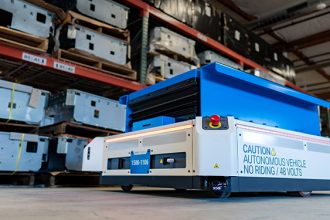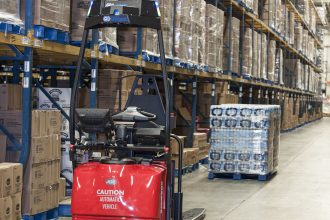Automation for the Cold Chain

In demand but difficult to staff, environmentally controlled warehousing is calling out for automated solutions.
Varying temperature zones in a warehouse have always existed, but it wasn’t until recently that the cold chain really came to the forefront of operations. There are a couple of reasons it is now an area of focus for most warehouse managers. One is the pandemic—when new COVID vaccines emerged, they required very specific temperatures to maintain their integrity. Suddenly, everyone knew about cold storage.
But demand for cold storage goes beyond vaccines. It also includes the surge in ecommerce. This demand has bled over from dry goods, clothing, and other items and into groceries, too. The value of the cold storage market has grown tremendously in the past few years, from approximately $115 billion in 2021, to a projected $428 billion by 2028.
Secondly, the labor shortage has made hiring for the refrigerated and freezer spaces one of the most difficult tasks. If someone has a choice between working in ambient environments and one that is kept at a frozen and refrigerated temperature, there’s no debate. With high turnover rates, temp workers, sick time and more, finding bodies to work in these cold spaces is harder than ever. Even when you can find employees willing to work there, labor working in those cold environments need frequent breaks and cannot be as productive as in other areas.
Increasingly, the solution to all these issues is automation. The good news is that more than ever before, automation can work across temperature zones, which wasn’t always the case. Issues with varying temperatures include the lubricants that behave differently in different temperatures. Condensation will also impact the ability of various equipment to work effectively when moving from one temperature zone to another. Wiring and rechargeable batteries have also been a concern for automation providers in the past, but now, most of those issues have been solved and the equipment can seamlessly transfer across varying temperature zones. This improves KPIs and helps optimize throughput, space utilization and labor costs.
Because the cost of real estate is also up—especially for cold environments—one of the most popular types of automation in cold storage has become AMRs (autonomous mobile robots) and pallet shuttle which is a type of automated storage and retrieval systems (ASRS) due to their height and density. When operating in the cold chain, ASRS affords end users an automated solution for storage and picking, allowing labor to be optimized and decreasing the need for humans in that space.
Other technology includes conveyors, pallet shuttles and autonomous mobile robots, all of which now work well in a cold storage location. Underlying all of this is software—warehouse control systems (WCS) and warehouse execution systems (WES), which serve as the integration points from the automation to the warehouse management system (WMS).
If you’re struggling to fill jobs in your refrigerated spaces, reduce your cost per pick/pallet, there’s never been a better time to add automation to the equation.
Source: Ed Romaine
For more information about the Solutions Community: mhi.org/solutions-community
For further articles from the Solutions Community:
Are You Data Rich, Intelligence Poor?
For a Successful Software Implementation, Focus on the People
Sustainability in the Warehouse—Part 1
How to Use Software to Attract and Retain Talent
Digitization of Intralogistics: Software
Forward Pick Area—Design and Operations



